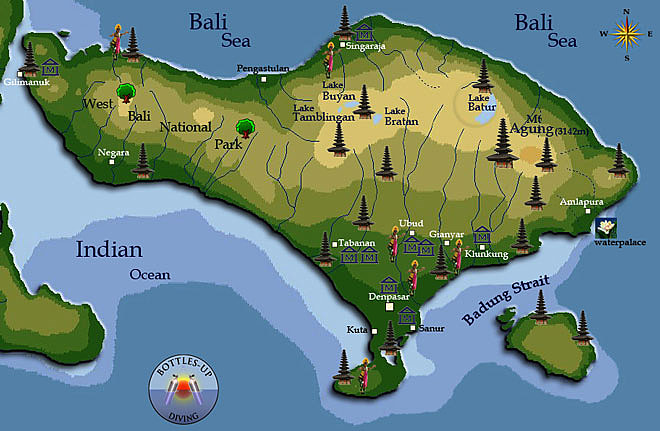Cultural highlights of Bali
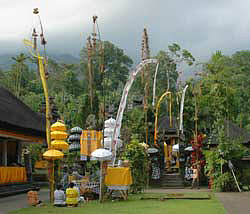
First thing you notice coming to Bali is the strong influence Hindu religion has on the society of these
island people.
In the beginning Balinese culture was strongly influenced by Indian and Chinese culture. Around the 1st century AD the
Hindu culture became very important.
Around 900 AD the complex irrigation system, Subak (see the section about Museums), was developed
to grow rice.
The Hindu Majapahit Empire (1293-1520 AD) on eastern Java founded a colony on Bali in 1343. When the empire declined, there was an exodus of intellectuals, artists, priests and musicians from Java to Bali in the 15th century.
With the latest census - official population count - from 2010, the current population of Bali stands at 3.890.757. The vast
majority (83,5%) of Indonesia's small Hindu minority lives here with the remainder of the population consisting of 13,4% Muslim,
2,5% Christian and 0,5% Buddhists.
It is also the largest tourist destination in the country and is renowned for its highly developed arts,
including dance, sculpture, painting, leather, metalworking and music.
The Balinese society is changing rapidly due to the large influx of jobseekers from other islands, mainly concentrating in the south
of the island. In 2005 for example, the island population stood at 3.151.000 of which 93,18% were Hindu.
The latest official figure of 2014 by the BPS (Bali Bureau of Statistics) sets the population number at 4.225.000.
Temples (pura) around Bali
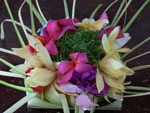
Balinese Hinduism is a combination of Buddhism, Animism and local traditions.
People believe that the Goddesses and Gods are everywhere and in everything. Offerings play a significant role
as they appease the spirits and thus bring prosperity and good health to the family.
 Every day small offering trays, 'canang sari',
containing symbolic food, flowers, cigarettes and money, are respectfully put on shrines, in temples, in front of houses
and shops, and at dangerous crossroads.
Every day small offering trays, 'canang sari',
containing symbolic food, flowers, cigarettes and money, are respectfully put on shrines, in temples, in front of houses
and shops, and at dangerous crossroads.
To begin with every house has at least one shrine or temple for daily offerings.
And then there are the 3 main temples in every desa (village):
Pura Puseh - The temple to worship Wisnu - God as Preserver, created by the village founders at
the "kaja" (towards the mountain) end of a village.
Pura Desa - The temple to worship Brahma - God as Creator, the village temple in the
middle of a village for the day-to-day ceremonial activities.
Pura Dalem - The temple to worship Siwa - God as Destroyer, the temple of the dead
at the "kelod" (towards the sea) end of a village where you can also find the cemetery.
Temples are the sites for village ceremonies such as cremations and larger festivals such as Galungan and Kuningan, which are held
every 210 days according to the Pawukon calendar.
The Pawukon, a 210-day ritual calendar brought over from Java in the 14th century,
is a complex cycle of numerological conjunctions that provides the basic schedule for ritual activities on Bali.
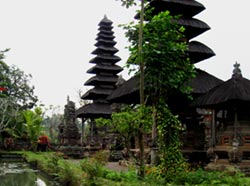
Driving around Bali you will find many impressive temples not even mentioned on the list below.
Usually it is allowed to enter them if you politely ask or in some cases pay an entrance fee or give a (up to you how much)
small donation.
There are however sections strictly reserved for the priest.
There is a dressing code for entering a temple; knees and, for women, shoulders should be covered.
If you like to enter one be sure to wear a sarong and sash - yellow waist band - and observe all signs regarding temple rules.
One of the more "unusual" ones is that pregnant or menstruating women are not allowed to enter.
As a rule of thumb better to visit temples in the morning or the afternoon because most of them offer little shade.
Directional Temples (pura) around Bali
Bali has 9 "kahyangan jagad" (directional temples) which protect the
island from evil spirits and occupy auspicious locations, such as the side of a mountain, cave or cliff top.
These holy temples are placed on each of the 8 directions around the most important temple in the centre.
Starting from the centre with:
Pura Besakih - Centre
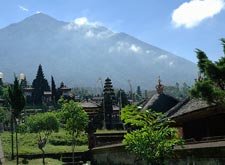
Bali's "mother temple", the largest and most holy temple in Bali, is over 900 metres up the slopes of Agung mountain.
It has been regarded as a holy place since pre-historic times in Bali. The first recorded mention of its existence is from an inscription
that dates from 1007 A.D. Since the Gelgel dynasty of the fifteenth century it has been regarded as a central, holy
temple for the entire island.
All the allegiances of the Balinese people come together at Besakih.
Each regency has its own temple within the overall compound, as do each of the caste groups. There is a total of 18 separate sanctuaries.
Besakih is primarily dedicated to Sang Hyang Widi Wasa (Shiva), but there are smaller temples dedicated to other gods.
Then there are the 4 Mandala temples ("Mandala" is Sanskrit for "circle"):
- Pura Batu Madeg : Temple of the standing stone, dedicated to
>Wisnu, North.
- Pura Gelap : Temple of lightning, dedicated to
Iswara, East.
- Pura Kiduling Kreteg : Temple south of the bridge, dedicated to
Brahma, South.
- Pura Ulun Kulkul : Temple of the origin of the Slit-Gong, dedicated to
Mahadewa, West.
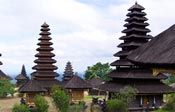
To the Balinese a visit to the temple sanctuaries at Besakih is a special pilgrimage.
Each temple has its own odalan, or anniversary celebration, and on the full moon of the Balinese month Kedasa the entire compound of Besakih celebrates the visit of the gods, with an enormous throng of visiting pilgrims.
Most of the Besakih temple complex was spared during the eruption of Mt. Agung in 1963 and since then the temple has become even more sacred.
Pura Lempuyang - East
This temple complex is perched on a hill top of Mt. Seraya at 768m and offers spectacular views of Mt. Agung.
Festival days are the best time to visit, when the 1700 steps up to the temple are filled with worshippers,
and extra public bemos run almost all the way to the temple.
Pura Goa Lawah - South East
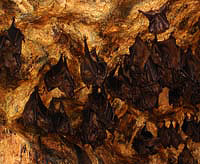
About 3 kilometers from Kusamba this "cave of the bats", built in the 11th century by the
high priest Empu Kuturan, is one of the most sacred temples in Bali.
Inside the temple, one will find a small natural cave inhabited by thousands of bats hanging down from the ceiling.
Bat droppings and the accompanying smell combined with tour groups can make this temple less attractive to visit.
However, you will pass it when traveling along the East coast so a brief stop is easy.
This temple is devoted to the deity Naga Basuki, a giant snake which is believed to live inside the cave.
Pura Andaksa - South
Pura Luhur Andakasa (on top of a hill), Antiga village, Manggis district, Karangsem regency.
Pura Luhur Uluwatu - South West
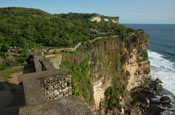
The location is dramatic, perched on the edge of a high cliff with a beautiful sunset view.
The temple was first used for worship by the holy 11th century priest, Empu Kuturan, who came to
Bali to bring religious law and to form Desa Adat (traditional villages).
Filled with the scent of frangipani blossoms and home to the relatively friendly Balinese long-tailed Macaques
(Macaca fascicuiaris).
Relatively because they are famous for snatching valuables like (sun)glasses, earrings, food, well actually anything they can get their little hands on!
Pura Luhur Batukaru - West
Pura Luhur Batukaru protects Bali from the West, originally built in the 11th century and was dedicated to the
ancestors of the rajahs of Tabanan. The temple was destroyed in 1604, but rebuilt in 1959.
The most important shrine at Pura Luhur Batukaru is the 7-tiered meru (multi-roofed shrine) that is in honour
of the God of Gunung Batukaru, Mahadewa.
Because of its beautiful location and architecture one not to skip when in the neighbourhood!
Pura Puncak Manggu - North West
This temple is located on the rim of the caldera from Mt. Peggilingan (2098m), on a hill top called gunung Manggu, above Lake Bratan.
To reach this temple you need to hike up the summit, which takes about 2.5 hours, through beautiful rainforest.
Ancient Pura Puncak Mangu, built by Mengwi's first raja and is a simple, peaceful temple with two "meru".
Pura Ulun Danu Bratan
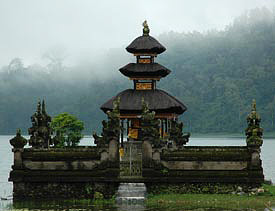
Not a directional temple but worth mentioning is the Pura Ulun Danu Bratan on the foot of Lake Bratan.
The King of Mengwi built this temple in 1633 and is one of the most photographed temples in Bali and for good reasons.
The meru temple (main temple) is situated on a little island just of the shore of lake Bratan.
This is one of the major lakes, like lake Batur, that supplies the irrigation waters for rice fields all over Bali and the temple is therefore
dedicated to the Goddess of the Lake.
Pilgrims come from all over Bali to ask her to bless them with bountiful crops.
There are actually three temples here, the main temple in the water, the Pura Teratai Bang, or the Black Lotus Temple,
on shore dedicated to the God Brahma, and the smallest temple for the Goddess of Food and Drink, Dewi Bhogawati (see photo).
To reach the shore you go through a well maintained park with a beautiful Bhuddist stupa.
Next to the park, but seamless integrated with it, is a hotel with bungalows where you can have a drink or a bite to eat.
Pura Ulun Danu Batur - North
This enormous complex of nine temples is located in Batur Village, Kintamani. In 1926 there was a big eruption of the Batur volcano which destroyed
the village and the temple complex, except for the most important shrine, an 11-tiered meru dedicated to Dewi Batari Ulun Danu.
The principle temple, Pura Penataran Agung Batur, houses five multi-tiered shrines dedicated to deities and
saints.
Each pura, temple, serves a specific purpose, spiritual (in honor of the gods) or worldly
(agriculture, craftwork, hot springs and the like).
People, especially farmers come from all over Bali to worship Vishnu because of the temple's strong connection with irrigation and proximity
to Lake Batur.
Each year, a grand temple festival takes place here during the 10th Balinese month.
Pura Pasar Agung - North East
Located on the Southern slopes of Mt. Agung in East Bali.
Sea Temples (pura) around Bali
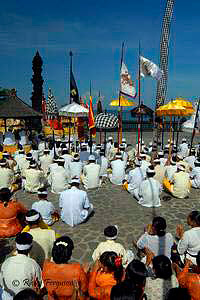
Bali also has a set of "sea temples" which were founded in the 16th century by a Hindi monk from Java named
Danghnyang Nirartha to honour the sea gods.
These sea temples are found (mostly) on the Western coast of Bali and were intended to be within sight of each other (which requires bionic-man eyesight).
They include the following:
Pura Gede Perancak
At the place were Danghnyang Nirartha landed in 1546, close to Negara.
Danghnyang Nirartha was the founder of the Shaivite priesthood in Bali. Shaivism, names the oldest of the
four sects of Hinduism. Followers of Shaivism, revere Shiva as the Supreme Being.
They believe that Shiva is All and in all, the creator, preserver, destroyer, revealer and concealer of all that is.
Pura Rambut Siwi
The name means "worship of the hair" since Danghyang Nirartha made a gift of a lock of his hair to this temple.
The complex of Pura Rambut Siwi consists of three temple enclosures:
the Pura Luhur, Pura Penataran and Pura Melanting.
The entrance of this temple is guarded by beautifully carved wild boar and dragon statue.
The Pura Luhur where Danghyang Nirartha's hair is kept is the first temple the visitors will encounter as they enter the temple complex.
This is the largest and most important temple.
A majestic candi bentar or split gate on the Southern wall of the inner courtyard opens onto
the cliff, offering dramatic views over the Indian Ocean. Inside are shrines to Dewi Saraswati (Goddess of learning) and
Dewi Sri (Rice Goddess).
Pura Tanah Lot
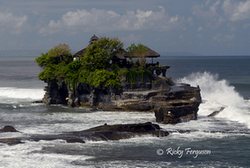
Another icon of Bali, this temple is situated about 50m from the shore.
Unfortunately it is forbidden, but at low tide you could walk to the temple without getting you feet wet.
The worst time to go there is at sunset when the crowds show up to make the obligatory
picture of the temple with in the background the sun setting in the sea.
It's a better idea to go there during the day when all the hawkers are still asleep or doing something else and the roads to the temple are still accessible.
Pura Luhur Uluwatu
This is the only Sea temple that is also one of the nine Balinese directional temples. See the description above...
Pura Mas Suka
Situated at the most southern tip of Bali. Nowadays easier to reach because of the development boom going on in the Bukit.
Pura Mas Suka offers a spectecular view the Indian Ocean.
Pura Sakenan
On Pulau Serangan (turtle island) this is a temple which is important to the Balinese but esthetically less interesting.
Pura Pulaki
This temple is situated north-east from Gilimanuk. Completely rebuild in the 1980's and full with the usual temple monkeys.
Important for business people, this is the place to pray to the God of prosperity MELANTING.
Dances around Bali
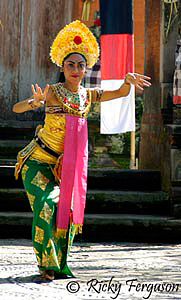
The lifestyles of the Balinese people is expressed in their dances which are performed during temple festivals
and in ceremonies.
The Balinese religion is intertwined in their dance performances as is daily life.
Balinese dance goes as far back as Balinese written history with much of the heritage originating from Java.
As a result of the Islamisation of Java, the dances are performed less on Java, but they have become part of the classical Balinese
culture.
Every dancer will pray before a performance at their family shrine for taksu (inspiration) from the gods, even for a
tourists performance.
Dance fulfills a number of specific functions:
It may be a channel for visiting gods or demons, the dancers acting as a sort of living repository.
It may also be as a welcome or entertainment for visiting gods.
The typical posture of Balinese dance has the legs half-bent, the torso shifted to one side with the elbow raised and lowered in a
gesture that displays suppleness of the hands and fingers.
The torso is shifted in symmetry with the arms. If the arms are to the right, the shifting is to the left and vice-versa.
Most Balinese dance performances are held in the evenings, however, you can also see some Barong Dance performances in the morning.
The following dances are the most popular and widespread :
Barong Dance
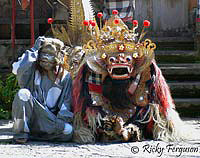
Together with the Kecak-dance this is the most popular dance for tourist. This dance is about the battle between the opposing forces
of chaos and destruction (Rangda), the evil widow-witch, and order (Barong),
the friendly funloving demon who looks like a dog-lion.
Performances in Suwung and Kesiman (suburbs of Denpasar), Batubulan, Banjar Abasan, Singapadu and at Puri Saren in Ubud.
Legong Dance
A highly stylized, extremely difficult dance performed by young girls. Choreographed to the finest details, and no improvisation allowed. Performances at Pura Dalem, Puri Peliatan in Ubud and at Puri Saren in Ubud.
Kecak Dance
A ritual dance created in the early 1930's for the movie "Island of the Demons" by the German painter and intellectual Walter Spies
who combined the chorus of the Sanghyang trance dance with a story from the Ramayana
legend.
Very impressive with its circular chorus (chak-a-chak-a-chak) of sometimes over 100 bare chested male singers.
Performances are held at the Arts Center in Denpasar, Banjar Tegal in Ubud and at the Pura Uluwatu.
Sanghyang
The Fire Dance is an exorcist dance to drive out evil spirits. Sanghyang is a divine spirit who temporarily takes over the body
of the dancer. There are 2 versions:
the Sangyang Dedari were two young girls dance in perfect symmetry while their eyes are shut with accompanying
background chanting and the Sanghyang Jaran or "fire dance" were a boy dances through a carpet of
smouldering coconut chips.
The latter is usually the final part of the Kecak dance. Performances at Bona Kangin
and Bonasari in Gianyar and in Batubulan.
Ramayana Dance
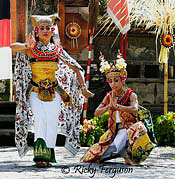
This dance tells a story from the Ramayana, one of the great Hindu holy books, about Prince Rama and Princess Sita.
The evil Rawana, King of Lanka, lures Rama away with a golden deer. Rama leaves the princess and when she is alone Rawana abducts her and carries
here away to his hideaway.
The prince comes to her rescue, but he also gets captured. Luckily he can call upon Garuda (mythical man-bird creature)
who helps him escape. Finally Sugriwa, the monkey King, comes with an army of monkeys and after a great battle good wins over evil
and Rama and Sitra can return home.
There are occasional performances of this Balinese dance at Nusa Dua Beach Hotel & Spa.
Museums around Bali
There are a number of museums in Bali. Most, if not all, of them are not very big and can be visited while on the way from one location to another as a break.
Museum Puri Lukisan in Ubud
Founded by Dutchman Rudolf Bonnet and royal Prince Cokorda Gde Agung Sukawati, it is the first museum of its kind in Bali.
This museum has a wide variety of Balinese sculptures and paintings ranging from classical wayang-style
paintings to more modern paintings from young artists, all well kept and displayed.
The third of the three pavilions is used for special exhibitions.
Museum Neka in Ubud
This museum stores fine arts from the Kamasan style of the 16th century until the modern painting from the 20th
century.
The collection is displayed chronologically, so it is able to describe the development of Bali fine art historically,
from the oldest time until the influence of the foreign arts that have enriched the Balinese fine art.
There is also a "Photography Archive Centre" with b&w photo's from Bali in the 1930's and 1940's and well worth visiting
Museum Nyoman Rudana in Ubud
This three storey museum in Mas village, takes a Tri Angga conception, which means the three parts of the human body; head, corpus, and legs.
The collection consists of over 400 works of Balinese painters from the glory of the Klungkung Kingdom until this very day.
Museum Agung Rai in Ubud
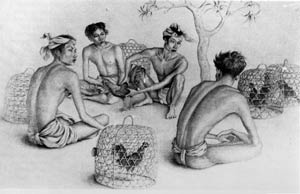
With works of Walter Spies, Rudolf Bonnet, Le Mayeur and Javanese artist Raden Saleh this museum is not only interesting for its collection, but also for the many other activities like gamelan- and dance practises. You can also take a walk in beautifully landscaped garden.
Museum Le Mayeur in Sanur
A museum set in the house where he lived with his partner, former Legong dancer Ni Polok, whom he met in 1932 when he arrived in Bali. The entire collection on display consists of his own work.
Museum Subak in Tabanan
Subak is the system of distributing water to the rice field through an intricate system of canals.
The guardian of this system is situated with his rice field at the lower end of the canals, and is thus both
aware of any problems which might arise and, because of his location, not in a position to misuse his power.
A very clever system and typical for Bali.
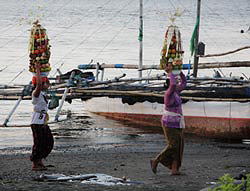
Museum Negeri Propinsi Bali in Denpasar
Established in 1910, but unfortunately destroyed by a 1917 earthquake. The museum was rebuild in 1920 and since 1932 the collection
has improved.
Museum Negeri Propinsi Bali is dedicated to collecting and preserving Balinese culture.
Comprising several buildings and pavilions it has a wide variety of archaeological and ethnographical objects covering every aspect
of Balinese life.
Museum Gedong Kirtya in Singaraja
Established in 1928 by the Dutch it has a large collection of books and chronicles written on dried palm leaves
(lontar), as well as some even older written works in the form of inscribed copper plates.
It also has a collection of Dutch publications dating back to 1901.
Museum Manusia Yadnya in Taman Ayun
Here you will find in detail items that connect with the human life process, from birth until death.
Museum Purbakala in Bedulu
The collection consists of archeological items such as early pottery and sarcophaguses dating back as early as 300 BC. Some originating from Bangli are carved in the shape of a turtle which has important cosmic associations in Balinese mythology.
Museum Semarajaya in Klungkung
 Recently renovated museum with a collection of archeological findings.
Recently renovated museum with a collection of archeological findings.
It also has an exhibition on songket weaving, salt-making and the making of palm wine and palm sugar.
Museum Manusia Purba in Gilimanuk
Founded in the 1990's, as a result of an archaeological finding from R.P. Soejoeno of the Bali Archaeological Service in 1962 in Dukuh Cekik. It was discovered that approximately 2000 years ago there lived a group of people for 200 years in the area where the museum is now located.
The Water palace
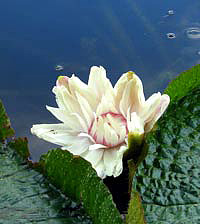
Ujung Water Palace is known by Balinese people as Taman Soekasada Ujung. The construction of the complex
was ordered by King I Gusti Bagus Jelantik of Karengasem (reigning period 1909-1945) in 1912 and finished in 1919.
The complex of this water palace is a combination of Balinese and European architecture.
The intentions of the king, to combine art and nature with geometrical forms from both Balinese spiritual symbolism and European
court-culture, becomes clear when looking at the gardens from this high point.
There are three large water-basins, in which
piers and stones lead along statues. The basins represent three stages from Hinduism: underworld, earth and heaven.
In the basin, that symbolizes the earth, are stepping stones made like a chess game, life portrayed as a continuing confrontation between
two parties. There are beautiful Lotus plants in the basin only accessible to insects and little frogs.
Before restoration only the stairs on the East side leading to a pagoda remained after the eruption of Mt. Agung in 1963.
Other than diving
Bali has so much to offer for a relatively small island....
Symbols used:
- Main temples
- Dance performances
- Museums

